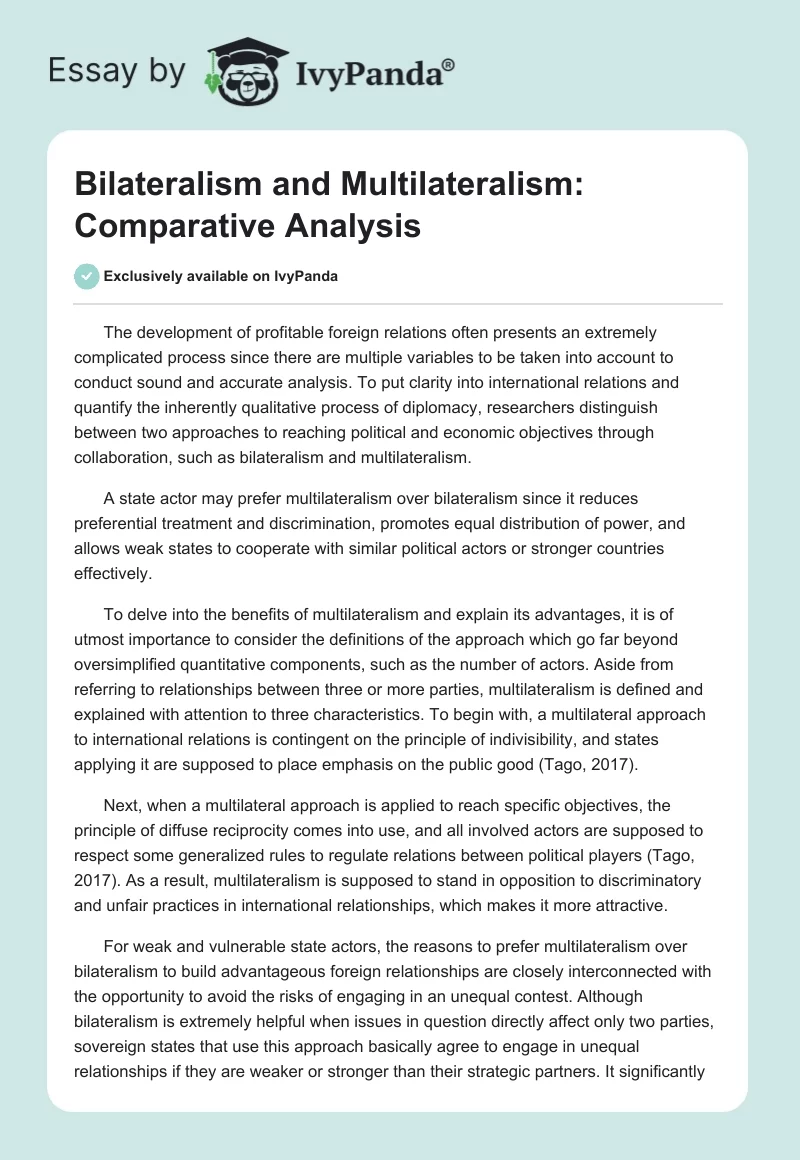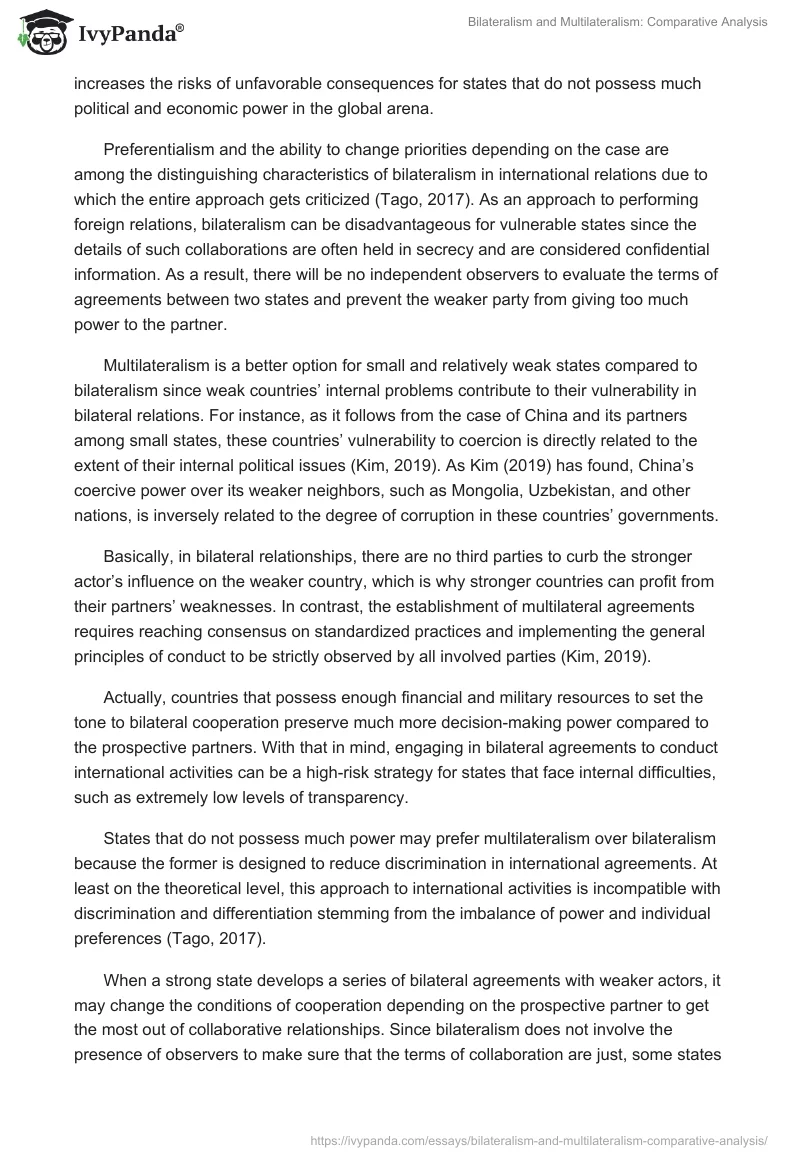The development of profitable foreign relations often presents an extremely complicated process since there are multiple variables to be taken into account to conduct sound and accurate analysis. To put clarity into international relations and quantify the inherently qualitative process of diplomacy, researchers distinguish between two approaches to reaching political and economic objectives through collaboration, such as bilateralism and multilateralism.
A state actor may prefer multilateralism over bilateralism since it reduces preferential treatment and discrimination, promotes equal distribution of power, and allows weak states to cooperate with similar political actors or stronger countries effectively.
To delve into the benefits of multilateralism and explain its advantages, it is of utmost importance to consider the definitions of the approach which go far beyond oversimplified quantitative components, such as the number of actors. Aside from referring to relationships between three or more parties, multilateralism is defined and explained with attention to three characteristics. To begin with, a multilateral approach to international relations is contingent on the principle of indivisibility, and states applying it are supposed to place emphasis on the public good (Tago, 2017).
Next, when a multilateral approach is applied to reach specific objectives, the principle of diffuse reciprocity comes into use, and all involved actors are supposed to respect some generalized rules to regulate relations between political players (Tago, 2017). As a result, multilateralism is supposed to stand in opposition to discriminatory and unfair practices in international relationships, which makes it more attractive.
For weak and vulnerable state actors, the reasons to prefer multilateralism over bilateralism to build advantageous foreign relationships are closely interconnected with the opportunity to avoid the risks of engaging in an unequal contest. Although bilateralism is extremely helpful when issues in question directly affect only two parties, sovereign states that use this approach basically agree to engage in unequal relationships if they are weaker or stronger than their strategic partners. It significantly increases the risks of unfavorable consequences for states that do not possess much political and economic power in the global arena.
Preferentialism and the ability to change priorities depending on the case are among the distinguishing characteristics of bilateralism in international relations due to which the entire approach gets criticized (Tago, 2017). As an approach to performing foreign relations, bilateralism can be disadvantageous for vulnerable states since the details of such collaborations are often held in secrecy and are considered confidential information. As a result, there will be no independent observers to evaluate the terms of agreements between two states and prevent the weaker party from giving too much power to the partner.
Multilateralism is a better option for small and relatively weak states compared to bilateralism since weak countries’ internal problems contribute to their vulnerability in bilateral relations. For instance, as it follows from the case of China and its partners among small states, these countries’ vulnerability to coercion is directly related to the extent of their internal political issues (Kim, 2019). As Kim (2019) has found, China’s coercive power over its weaker neighbors, such as Mongolia, Uzbekistan, and other nations, is inversely related to the degree of corruption in these countries’ governments.
Basically, in bilateral relationships, there are no third parties to curb the stronger actor’s influence on the weaker country, which is why stronger countries can profit from their partners’ weaknesses. In contrast, the establishment of multilateral agreements requires reaching consensus on standardized practices and implementing the general principles of conduct to be strictly observed by all involved parties (Kim, 2019).
Actually, countries that possess enough financial and military resources to set the tone to bilateral cooperation preserve much more decision-making power compared to the prospective partners. With that in mind, engaging in bilateral agreements to conduct international activities can be a high-risk strategy for states that face internal difficulties, such as extremely low levels of transparency.
States that do not possess much power may prefer multilateralism over bilateralism because the former is designed to reduce discrimination in international agreements. At least on the theoretical level, this approach to international activities is incompatible with discrimination and differentiation stemming from the imbalance of power and individual preferences (Tago, 2017).
When a strong state develops a series of bilateral agreements with weaker actors, it may change the conditions of cooperation depending on the prospective partner to get the most out of collaborative relationships. Since bilateralism does not involve the presence of observers to make sure that the terms of collaboration are just, some states will get less advantageous offers than the others. In multilateral settings, states that join a particular agreement are supposed to accept one and the same offer, which is especially significant for weaker actors that are easy to manipulate.
Performing their foreign relations through multilateralism is also a better option compared to bilateralism since it enables small and middle powers to unite with similar actors or win the support of superpowers. What is often referred to as the Lilliput strategy (smaller states that become more influential by uniting and providing mutual support) could be possible due to the existence of multilateralism.
However, the examples of relatively weak states using multilateralism to gather the support of superpowers without taking risks peculiar to bilateral relations are more common. For instance, as Crump and Romano (2020) argue, both East and West European countries resorted to multilateral strategies during the Cold War era to “stretch their room for manoeuvre” and gather the opportunity to influence the global balance of power (p. 13). At the same time, bilateralism does not give much decision-making power to smaller and more vulnerable states.
To sum it up, the terms “bilateralism” and “multilateralism” refer to drastically different approaches to developing international relations. State actors, especially vulnerable and small states, may prefer multilateralism since it has a number of advantages over bilateral relationships. They include the opportunity to control cooperation and make sure that all activities are fair and align with international norms. Additionally, unlike bilateralism, a multilateral approach to international cooperation involves mechanisms to reduce discrimination and inequality between partners.
References
Crump, L., & Romano, A. (2020). Challenging the superpower straitjacket (1965–1975): Multilateralism as an instrument of smaller powers. In L. Crump & A. Romano (Eds.), Margins for manoeuvre in Cold War Europe: The influence of smaller powers (pp. 13-31). New York, NY: Routledge.
Kim, S. C. (2019). China and its neighbors: Asymmetrical economies and vulnerability to coercion. Issues & Studies: A Social Science Quarterly on China, Taiwan, and East Asian Affairs, 55(4), 1-25.
Tago, A. (2017). Multilateralism, bilateralism, and unilateralism in foreign policy. Oxford Research Encyclopedia of Politics. Web.



